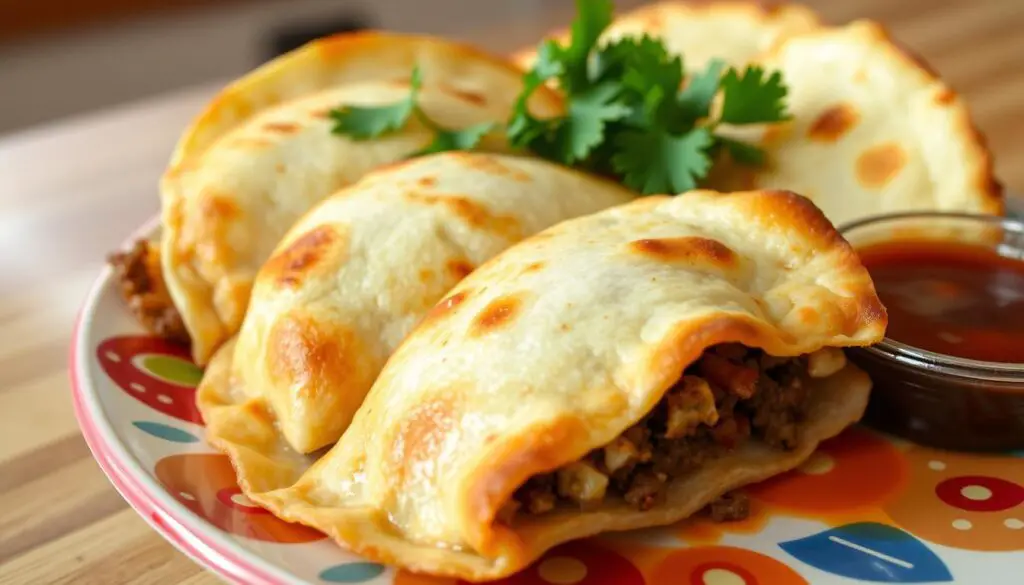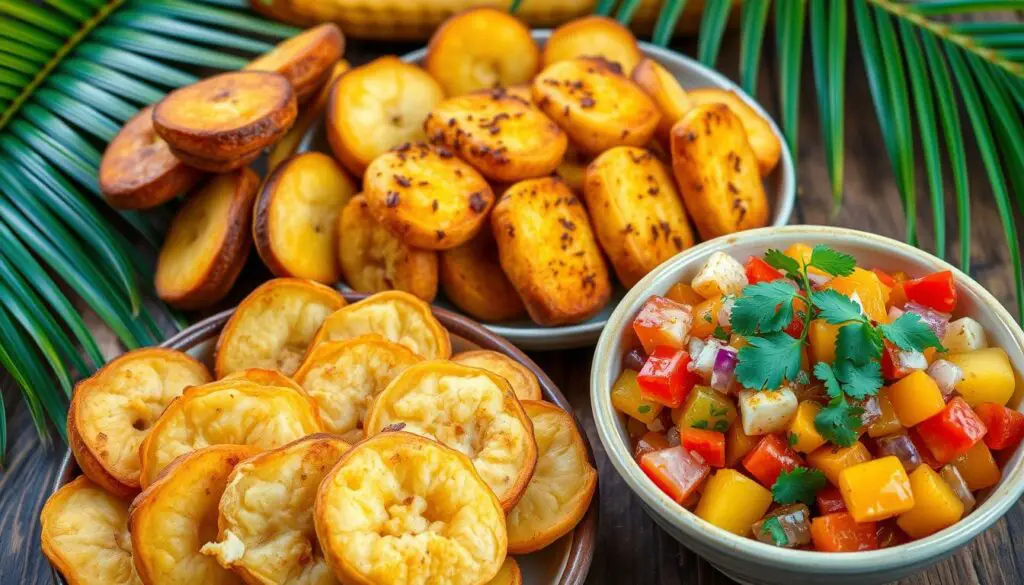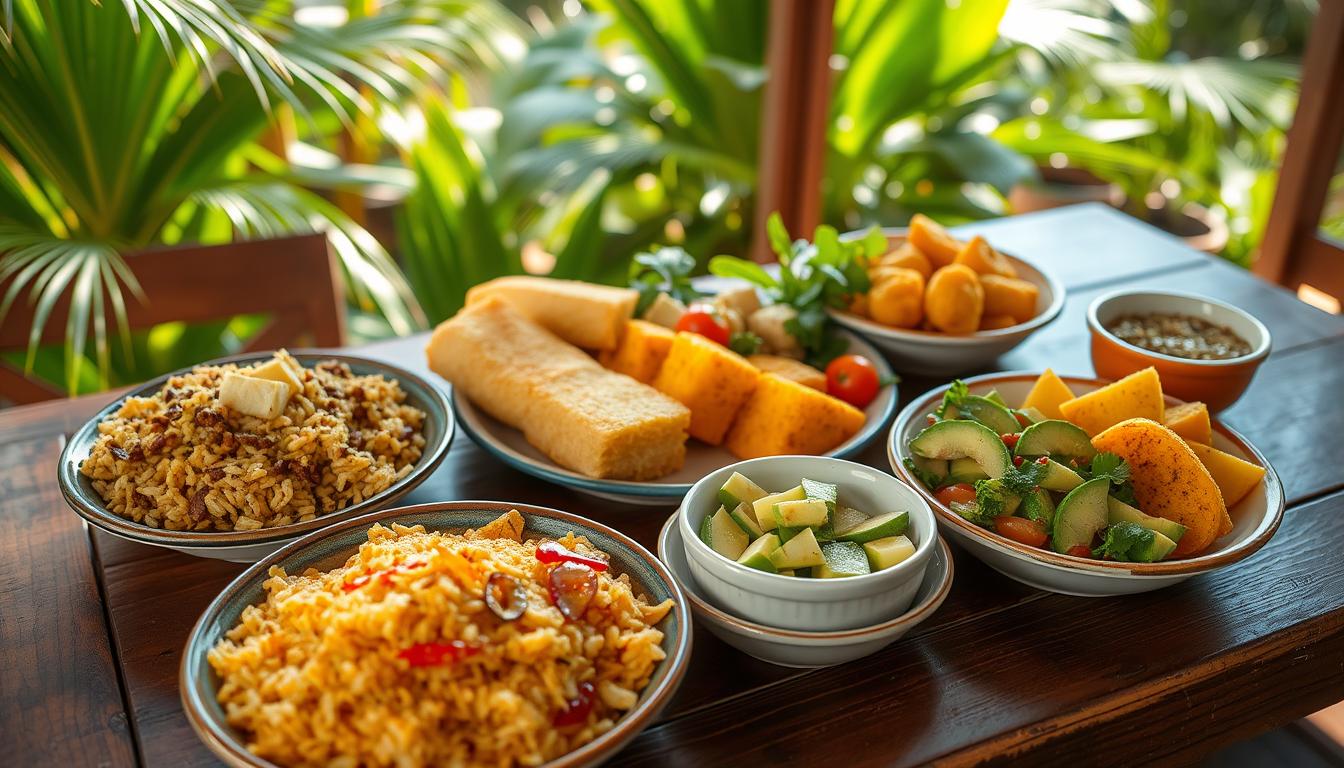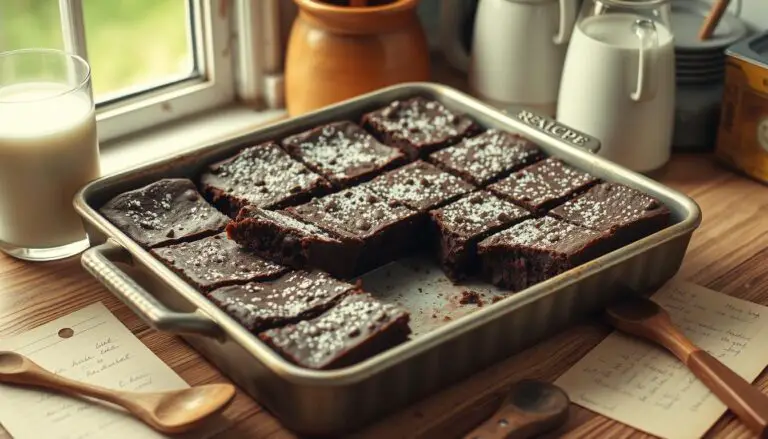Tasty Puerto Rican Lunch Recipes You’ll Love
Have you ever wondered why Puerto Rican lunch recipes are so special? They mix rich flavors with deep traditions. The world of comida criolla shows a wide range of traditional dishes. These dishes not only excite your taste buds but also celebrate a unique heritage.
From mofongo, made with fried green plantains and filled with chicharrones, to arroz con gandules, each recipe is a masterpiece. This article invites you to try beloved Puerto Rican meals. You might find your new favorites as you explore flavors that truly capture the essence of Puerto Rican cuisine1.
Key Takeaways
- Puerto Rican cuisine is rich in flavors and history, making it a cultural treasure.
- Traditional dishes like mofongo and arroz con gandules are essential to Puerto Rican lunches.
- Each recipe tells a story, showcasing the vibrant spirit of the island’s culinary artistry.
- Comida criolla is a celebration of diverse ingredients and cooking techniques.
- Exploring these recipes can bring a taste of Puerto Rico into your home.
Exploring Comida Criolla: Traditional Puerto Rican Cuisine
Comida criolla is at the heart of Puerto Rican food, blending flavors and techniques. It reflects the island’s rich cultural mix. The first restaurant, La Mallorquina, opened in 1848 in Old San Juan. It started a culinary journey that shows Puerto Rico’s diverse flavors2.
Key ingredients like rice, beans, plantains, and tropical meats are found in many dishes. Arroz con gandules, with its pigeon peas, is Puerto Rico’s national dish3. Mofongo, from African slaves, and lechón asado, slow-roasted pork, are big in celebrations3.
African influences are seen in dishes like bacalaitos and pasteles. Spanish chorizo sausage is used in arroz con pollo2. Mallorcas, a sweet treat, have a cakier texture, showing Spanish bakery traditions2. Breadfruit, introduced in 1793, is now common, often replacing plantains2.
These dishes celebrate Puerto Rico’s culture and bring families together. Today, they’re getting a gourmet makeover with fresh herbs and fruits. The growing popularity of hot sauces made with scotch bonnet peppers shows how tastes are changing3.
Why Mofongo is a Must-Try
Mofongo is a key dish that shows the heart of Puerto Rican comfort food. It’s a must-try for those who love plantain dishes. This recipe uses fried green plantains mixed with garlic, salt, and pork cracklings or bacon. It creates a flavor mix that warms your heart4.
It’s often served with pernil, slow-roasted pork, or other meats like steak, shrimp, or octopus. Mofongo is a versatile dish that makes a satisfying meal5.
The roots of mofongo come from a mix of Spanish, African, and Indigenous cultures. This mix shows Puerto Rico’s rich culinary history5. Families and regions have their own ways of making mofongo, adding seafood or vegetables. This shows why mofongo is so loved in Puerto Rican food6.
Mofongo is a must-have in any Puerto Rican lunch. It has a rich texture and comforting flavors. People have given 392 ratings for mofongo recipes, showing its popularity6. For more on mofongo, check out this culinary resource.
Puerto Rican Lunch Recipes: A Fusion of Tropical Flavors
Pico de gallo, salsas, and tropical fruits are key in Puerto Rican lunch recipes. They mix flavors and textures in a unique way. Learning about authentic ingredients and cooking techniques makes cooking at home more fun. The mix of Puerto Rican and global cuisines also brings new trends, making the cuisine more exciting and diverse.
Key Ingredients for Authentic Dishes
Important parts of Puerto Rican food include sofrito, adobo, and tropical veggies. Ingredients like plantains, pork, and coconut milk add flavor and show the island’s rich food history. Dishes like arroz con gandules and mofongo use sazón and achiote oil for color and taste. This shows the mix of Taíno, African, and Spanish influences in the cuisine7.
Diverse Cooking Techniques
Cooking methods range from slow-cooking to sous-vide, adding a modern twist. Frying and steaming improve taste and texture. Marinating, especially with garlic and oregano, is crucial for dishes like pernil. Each method is vital for capturing the tropical flavors of Puerto Rican food8. As trends change, new methods help keep traditional dishes fresh and appealing to today’s tastes9.
Classic Arroz con Gandules: A Family Favorite
Arroz con gandules is a beloved dish in Puerto Rico, often called the national dish. It’s made with pigeon peas, white rice, and sofrito. The sofrito adds a rich flavor to the dish.
This recipe makes about 8 servings and takes 50 minutes to prepare and cook. It includes 10 minutes of prep and 30 minutes of cooking, plus 10 minutes for resting. Each serving has 441 calories, with 77g of carbs, 9g of protein, and 10g of fat. It’s perfect for family meals and holidays1011.
This dish brings families together, especially during big celebrations. To make it, you’ll need 1-pound of pigeon peas, soaked overnight. You’ll also need olive oil or achiote oil, and 1/4 pound each of salt pork and lean ham11.
The recipe also includes a medium onion, a green bell pepper, and 1/4 cup of sofrito. Chopped green olives and capers add to the flavor. Tomato sauce or paste balances the taste, making it both unique and comforting.
When cooking arroz con gandules, rinse the rice well before cooking. Don’t stir the rice too much to keep its texture right. You can store it in the fridge for up to 5 days or freeze it for 3 months1011.
Alcapurrias: The Perfect Snack or Meal
Alcapurrias are a favorite in Puerto Rico. They are made from green plantains or yuca dough. You can fill them with many things, making them a hit for any meal.
Different Fillings You Can Use
Alcapurrias are great because you can fill them in many ways. Here are some favorites:
- Beef: Seasoned ground beef is a hearty choice.
- Chicken: Shredded chicken is a lighter option.
- Crab: Crab is perfect for seafood fans.
- Vegetables: Vegetables are great for those who don’t eat meat.
With so many fillings, alcapurrias please everyone’s taste.
Serving Suggestions
Here’s how to make your alcapurrias even better:
- Hot Sauce: A little hot sauce adds spice.
- Salad: A fresh salad balances out the meal.
- Dip: Try a tangy sauce for extra flavor.
Alcapurrias are perfect for any time. They take about 1 hour and 15 minutes to make. You can serve up to 15 of them12. This dish is a big part of Puerto Rican food culture.
Empanadillas: Quick and Delicious Puerto Rican Pastries
Empanadillas are a key part of Puerto Rican pastries. They are tasty and wrapped in a flaky crust. You can bake or fry them, making them perfect for any diet.
The dough makes 22 to 25 discs, great for family meals or prep13. It takes 20 minutes to mix and knead. Then, 25 minutes to cook, plus 30 minutes to chill. This makes about 1 hour and 15 minutes of work13.
Each empanada disk has about 149 calories. It has 17g of carbs, 3g of protein, and 8g of fat13. This lets you enjoy them while keeping an eye on your diet.
Empanadillas are often filled with ground beef. But, ground pork is also popular for its taste14. You can fill them with seasoned meats, cheese, and veggies for different flavors. Using store-bought dough from Goya or La Fe can save a lot of time14.
- Ground pork with homemade sofrito, Goya Adobo, and spices
- Shredded cheese for a cheesy delight
- Ground beef for a classic take
- Mixed vegetables for a vegetarian option
To fry, dip 10 empanada discs in 2 inches of oil. Make sure they reach 160°F inside14. A fried empanadilla is crispy outside and full of flavor.

Perfecting the Sofrito: The Heart of Puerto Rican Cooking
Sofrito is key in Puerto Rican cooking, acting as the base for many tasty dishes. Knowing its ingredients and how to make it at home can boost your cooking skills.
Common Ingredients Used in Sofrito
The basic sofrito recipe includes:
- 2 green bell peppers
- 2 cubanelle peppers
- 1 red bell pepper
- 15 Aji Dulces (sweet peppers)
- 2 bunches of cilantro
- 2 bunches of culantro
- 2 heads of garlic
- 1 medium yellow onion
- 1 medium red onion
- Juice of 1 orange
- Juice of 1 lemon
- 1/2 teaspoon of ground cumin
Sofrito can make many Puerto Rican dishes better. It’s great for arroz con gandules, picadillo, pollo guisado, pernil, soups, stews, and bean dishes like habichuelas guisadas1516.
How to Make Homemade Sofrito
Making homemade sofrito is easy:
- Roughly chop the vegetables.
- Process them in a food processor or blender until smooth.
- Check for consistency and adjust as needed.
- Use it right away or store it for future use.
Homemade sofrito can be kept in the fridge for up to two weeks. Or, freeze it in ice trays for up to six months1516. Freezing makes it easy to use in Caribbean dishes as needed.
If Aji Dulces are hard to find, use more green bell pepper. For culantro, use more cilantro15. This keeps the flavor right.
Plantain Dishes: Versatile and Flavorful Options
Plantains are key in Puerto Rican food, loved for their flexibility and tasty textures. Tostones and maduros are two famous dishes. Tostones are green plantains fried until crispy, great with meals or as a snack. Maduros are sweet ripe plantains, often served with meats or seafood.
These plantain dishes use tropical ingredients to add flavor to Puerto Rican meals. Here’s a simple recipe to try them at home:
- Tostones:
- Slice green plantains into 1-inch thick pieces.
- Fry for about 3-4 minutes until golden.
- Remove and flatten each piece.
- Fry again until crispy.
- Maduros:
- Peel ripe plantains and slice them diagonally.
- Fry in hot oil until golden brown on both sides.
- Drain excess oil and serve warm.
These dishes show how plantain dishes can please both sweet and savory tastes. They are part of Puerto Rico’s rich food traditions. Enjoy them with dishes like roasted pork or seafood.

Exploring Puerto Rican cuisine means trying these plantain dishes. They capture the essence of island life and add to the meal’s flavor.
“To fully enjoy the beauty of Puerto Rican flavors, one must embrace the potential of plantains.”
Plantain dishes are more than food; they symbolize Puerto Rican traditions and family gatherings. Cooking them authentically lets you taste the island in your kitchen1718.
Cooking Tips for Puerto Rican Lunch Recipes
Creating delicious Puerto Rican dishes is easier with the right tips. Using the right kitchen tools can make your meals better. Learning quick cooking methods can turn long recipes into quick, tasty meals for busy cooks.
Essential Kitchen Tools
Having these tools in your kitchen makes cooking Puerto Rican dishes smooth:
- Quality Pot – A good pot is key for dishes like arroz con gandules. It ensures even cooking and the right texture.
- Sturdy Cutting Knife – A sharp knife is essential for chopping ingredients fast and evenly. It’s crucial for making sofrito.
- Food Processor – A food processor makes sofrito prep easier. It blends herbs and veggies for the flavor base of many Puerto Rican dishes.
Time-Saving Techniques
These techniques can make cooking faster:
- Batch Cooking – Cook big batches of sofrito or beans and freeze them. This makes quick meals during the week.
- Utilizing Leftovers – Use leftovers to make new dishes. For example, turn leftover chicken into pollo guisado.
- Plan Ahead – Plan your meals for the week. Choose recipes that use the same ingredients to save time and reduce waste.
These tips help you cook with rich flavors and enjoy Puerto Rican cuisine without spending too much time. Learning these tools and techniques will make your meals enjoyable and celebrate Puerto Rican flavors192021.
Conclusion
Pueblo traditions come alive in every bite of Puerto Rican lunch recipes. These dishes show the deep cultural heritage and community spirit. They invite everyone to try and make their own versions of these classics.
From the aromatic sofrito to the rich Arroz con Gandules, these meals are more than food. They represent family and celebration.
Start your own culinary journey by using the vibrant ingredients and techniques of Puerto Rican cuisine. Each dish shares a story and connects you to this rich culture. Whether it’s hearty lechón asado or sweet tembleque, you’ll bring a bit of Puerto Rico home.
So, gather your family in the kitchen. Let the smells fill the air. Enjoy the joy of making and sharing these delicious Puerto Rican lunch recipes. It’s more than a meal; it’s a journey of flavors, a tribute to tradition, and a celebration of Puerto Rican culinary arts22.







